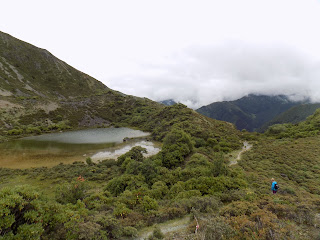Hiking in Tibetan China: Daocheng Yading National Park
Daocheng Yading Nature Reserve is in SW Sichuan Province, an area that is ethnically Tibetan although it is not part of the Tibetan Autonomous Region. When I was researching places to go hiking on my trip last summer, I found the blog "Land of Snows" and read this article about the park. The author's photos were absolutely stunning and I knew I had to go there myself.
Unfortunately, a lot has changed since the author of "Land of Snows" originally did his hike in the reserve, and now it is incredibly crowded thanks to the construction of an airport nearby. This means that people from all over China can be flown in in huge numbers, boarded onto tour buses with bottled oxygen, and delivered to the park very quickly. As a result you see a lot of people struggling to acclimate to the elevation and a lot of very unprepared tourists in sandals, high heels, etc. along the trails. It is also no longer possible to do the 2 day hike around Mt. Chenresig without having an official guide.
 |
| Driving through a canyon on the way to Daocheng |
 |
| Nomadic Tibetan huts in the countryside around Daocheng |
So the experience for me in the park was disappointing in some ways. I knew it would be crowded, but it was far worse than I expected. Even the first part of the trek around Mt. Chenresig, up to Milk Lake, was packed with people. To make matters worse, the day we did it was rainy off and on, so the trail was clogged with people in bad shoes and carrying umbrellas.
That said, we still managed to make our time in the reserve really worthwhile.
 |
| A Tibetan family's house, where we stayed the first night |
 |
| Making breakfast in the kitchen |
 |
| Our very hearty breakfast of porridge, eggs, and yak butter tea |
 |
| Homemade Tibetan bread |
 |
| Homemade yak jerky |
We got an early morning bus out of Shangri-la city in Yunnan Province headed toward the town of Daocheng in Sichuan Province. Along the way, the driver asked if anyone wanted to change to a bus headed into the reserve and we did, along with a couple from the Ukraine. the four of us arrived in a small village just outside the park, where there are a lot of big hotels to hold most of the tourists there on big group tours. We asked around and found a Tibetan family willing to host the four of us (me, Anna, and the Ukrainians) in their spare room. The family were incredibly friendly and generous, sharing snacks of home-made yak jerky and beer with us in the evening while we all attempted to chat in broken Mandarin. The next morning the parents of the family made us all a home-cooked breakfast of porridge, yak butter tea, and bread.
 |
| Entering the reserve |
 |
| In the little village inside the reserve, where we stayed |
 |
| A local Buddhist temple |
 |
| Our hotel in the village in the reserve |
 |
| Our Tibetan hosts, gathered around the hearth for some tea |
We packed up that day and headed into the park. There are buses along the road that you can hop on, which will take you to the park entrance. Then you will have to purchase the entrance ticket as well as a bus ticket, but once you enter the park, if you stay at a hotel inside, you won't have to pay again. We found a hotel at a very reasonable price once we were inside the park. It was also run by a local Tibetan family. They were just as friendly as the first family we stayed with, giving us more yak butter tea and lots of advice about where to go hiking and about the weather.
I would highly recommend just going straight into the park at staying at a Tibetan run hotel. A lot of the tourism industry has been developed by Han Chinese who are not local to the area, so whenever it's possible to give your tourist dollars to the local Tibetans, please do so. You can easily stay at their hotels, shop at their stores, and buy food from them, and it will be a much more interesting cultural experience as well.
The first day we hiked around some of the short, easy trails in the park. This allowed us to take our time acclimating to the elevation, which is over 4,000 meters even at some of the lower sections of the park. The first day I had some headaches and felt out of breath, but by the second day I no longer really noticed the elevation. We didn't need to purchase any bottled oxygen.
 |
| 5 Color Lake |
 |
| Milk Lake |
We did the hike up to see Milk Lake, which was very beautiful but unfortunately large parts of the trail were kind of ruined for me by all the crowds. It really wasn't the quiet, serene place I was expecting to find after reading the Land of Snows blog post. I enjoyed some of the early stages of the trail, however, which go through wetland areas and forests, and which many of the Chinese tourists skip altogether by taking a bus straight to the start of the Milk Lake trail.
This was during the rainy season so we only caught little glimpses of the three mountains in the park. The mountains are considered holy to the local Tibetans, and each one is considered the embodiment of a Buddhist Boddhisatva. Their Tibetan names are Jampelyang (Wisdom), Chana Dorje (Power), and Chenresig (Compassion). In some forms of Buddhism, there is a tradition of walking in a circuit around a sacred object, such as a prayer wheel, or in this case a sacred mountain. This practice is called a "kora", and the local Tibetans have been doing koras around the mountains in the park for many years. The kora around Mt Chenresig can be done in 1-2 days; if you do it in 2 days, there is a mountain hut just past Milk Lake and camping is allowed next to the hut. As I mentioned before, nowadays hikers are not allowed to do the kora without a guide. Please do not try to do it without a guide if you have been staying at a Tibetan hotel; if anything happens to you, your Tibetan hosts will be held responsible for you by the government and you could cause them a great deal of trouble.
 |
| Stunning views along the lesser-known local hiking trail |
 |
| A little lake on the lesser-known trail |
 |
| Some yaks we ran into along the way |
We got tired of all the crowds and asked our hosts if there were any other local hikes we could do. They recommended one that is accessible from the village in the reserve where we were staying; the trailhead was just down the hill from our hotel, although it was a little hard to find. The hike took us up into the mountains overlooking the village, wandering by creeks, forests, small herds of grazing yaks, and ended by a lake. We only saw a few other people on the trail the entire time, and finally had some of the peace and quiet we were hoping for. In many ways, this little hike was the highlight of our trip to the park.



















Comments
Post a Comment